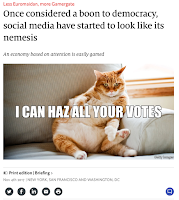The NY Times, December 5, 2017 on-line edition ran an
article “Russia Designates U.S.-Backed Broadcasters as ‘Foreign Agents’ (see: http://nyti.ms/2nIuUlF, which is also the
photo source). Interestingly enough the same article appeared in the December
6, 2017 print edition as “Russia, Retaliating, Targets U.S.-Based Broadcasters”
The article cites a 6 January intelligence report
“Background to “Assessing Russian Activities and Intentions in Recent US
Elections”: The Analytic Process and Cyber Incident Attribution” (which you can
find at: https://www.dni.gov/files/documents/ICA_2017_01.pdf)
. The Key Judgment found on page iii of the report is:
“Russia’s State-run propaganda machine
contributed to the influence campaign by serving as a platform for Kremlin
messaging to Russian and international audiences.”
The report cited several points that my Blog readers might
find of interest:
By their nature, Russian influence campaigns
are multifaceted and designed to be deniable because they use a mix of agents
of influence, cutouts, front organizations, and false-flag operations. Moscow
demonstrated this during the Ukraine crisis in 2014, when Russia deployed
forces and advisers to eastern Ukraine and denied it publicly. (Page 2)
Russia’s state-run propaganda
machine—comprised of its domestic media apparatus, outlets targeting global
audiences such as RT and Sputnik, and a network of quasi-government
trolls—contributed to the influence campaign by serving as a platform for
Kremlin messaging to Russian and international audiences. State-owned Russian
media made increasingly favorable comments about President-elect Trump as the
2016 US general and primary election campaigns progressed while consistently
offering negative coverage of Secretary Clinton. (Page 3)
Putin’s public views of the disclosures
suggest the Kremlin and the intelligence services will continue to consider
using cyber-enabled disclosure operations because of their belief that these
can accomplish Russian goals relatively easily without significant damage to
Russian interests. (Page 5)
RT's criticism of the US election was the latest facet of its
broader and longer-standing anti-US messaging likely aimed at undermining
viewers' trust in US democratic procedures and undercutting US criticism of
Russia's political system. RT Editor in Chief Margarita Simonyan recently
declared that the United States itself lacks democracy and that it has "no
moral right to teach the rest of the world" (Kommersant, 6
November). Page 7)
It is important to point out that Russian
propaganda efforts are aimed at further their economic goals as well as pointed
out in this comment on Page 8:
RT runs anti-fracking programming,
highlighting environmental issues and the impacts on public health. This is
likely reflective of the Russian Government's concern about the impact of
fracking and US natural gas production on the global energy market and the
potential challenges to Gazprom's profitability (5 October).
The Russians understand the importance of social media as
shown by a chart on Page 11 which featured this chart:
The implications for the PSYOP community are clear – we need
to be as familiar with nation sponsored, strategic communications as we are
with leaflets. The importance of Social Media such as Twitter and Facebook when
combined with the visual power of well-viewed videos such as found on YouTube
cannot be underestimated.
The Blog and I are taking a well deserved hiatus. We’ll be
backed after the New Year.
All the best to you and yours for the New Year.























